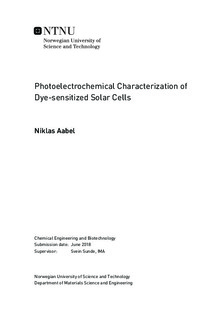Photoelectrochemical Characterization of Dye-sensitized Solar Cells
Abstract
Dye-sensitized solar cells, DSSCs, are thin film solar cells based on a photoelectrochemical system where a photo-sensitized anode and an electrolyte forms a semiconductor. Upon exposure of sunlight, the surface of the DSSC absorbs the photon energy, exciting electrons to a higher energy state. The electron is then transferred into the conduction band of a semiconductor where it in turn diffuses to the anode and through an outer circuit.
The most commonly applied solar cell technology today is direct conversion to electricity in photovoltaic units. However, current photovoltaic systems are quite complex and resource demanding. DSSCs meet the requirement of sufficient energy demands and offer a simpler technology, making them a potential substitute for photovoltaic cells in the future. Vital for the performance of DSSCs is the choice of dye. Most commonly Ruthenium complexes are used as dyes, but Ruthenium is quite scarce and expensive resulting in an interest for organic dyes. In this work, the impact of three organic dyes, AFB-18, AFB-19 and AFB-21, on the kinetic properties of DSSCs are studied. The results are benchmarked against the extensively studied organo-metallic dye N719. Current-voltage-characteristics, electrochemical impedance spectroscopy, EIS, and intensity modulated photo-current spectroscopy, IMPS, are measurements used for analyzing the cell's properties. The current-voltage-characterisitics showed promise that pure organic dyes can compete with the commonly used Ruthenium complexes in terms of performance. The differences in the current-voltage-characteristics for the different solar cells are explained through the corresponding time constants for transport and recombination.
